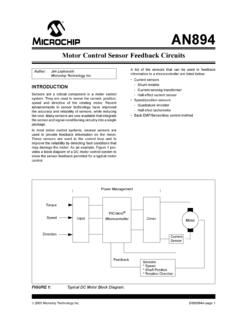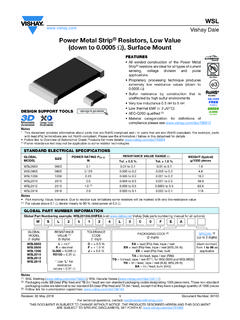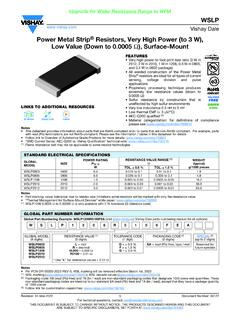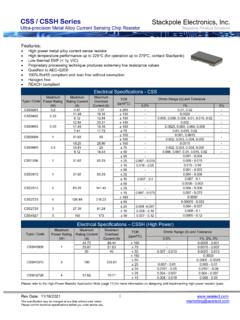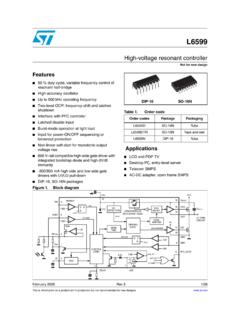Transcription of Current Sensing Circuit Concepts and Fundamentals
1 2010-2011 Microchip Technology 1AN1332 INTRODUCTIONC urrent Sensing is a fundamental requirement in a widerange of electronic applications. Typical applications that benefit from Current sensinginclude: Battery life indicators and chargers Overcurrent protection and supervising circuits Current and voltage regulators DC/DC converters Ground fault detectors Linear and switch-mode power supplies Proportional solenoid control, linear or PWM Medical diagnostic equipment Handheld communications devices Automotive power electronics Motor speed controls and overload protectionThis application note focuses on the Concepts andfundamentals of Current Sensing circuits.
2 It introducescurrent Sensing resistors, Current Sensing techniquesand describes three typical high-side Current sensingimplementations, with their advantages and disadvan-tages. The other Current Sensing implementations arebeyond the scope of this application note and reservedfor subsequent Microchip Technology Incorporated sapplication Sensing resistor DescriptionA Current sensor is a device that detects and convertscurrent to an easily measured output voltage, which isproportional to the Current through the measured path.
3 There are a wide variety of sensors, and each sensoris suitable for a specific Current range andenvironmental condition. No one sensor is optimum forall applications. Among these sensors, a Current Sensing resistor is themost commonly used. It can be considered a Current -to-voltage converter, where inserting a resistor into thecurrent path, the Current is converted to voltage in alinear way of V = I R. The main advantages and disadvantages of currentsensing resistors include:a) Advantages:- Low cost- High measurement accuracy - Measurable Current range from very low to medium- Capability to measure DC or AC currentb) Disadvantages:- Introduces additional resistance into the measured Circuit path, which may increase source output resistance and result in undesirable loading effect- Power loss since power dissipation P=I2 R.
4 Therefore, Current Sensing resistors are rarely used beyond the low and medium Current Sensing :Yang ZhenMicrochip Technology Sensing Circuit Concepts and FundamentalsAN1332DS01332B-page 2 2010-2011 Microchip Technology CriteriaThe disadvantages mentioned previously could bereduced by using low-value Sensing , the voltage drop across the Sensing resistormay become low enough to be comparable to the inputoffset voltage of subsequent analog conditioningcircuit, which would compromise the measurementaccuracy.
5 In addition, the Current Sensing resistor s inherentinductance must be low, if the measured Current has alarge high-frequency component. Otherwise, theinductance can induce an Electromotive Force (EMF)which will degrade the measurement accuracy as well. Furthermore, the resistance tolerance, temperaturecoefficient, thermal EMF, temperature rating and powerrating are also important parameters of the currentsensing resistors when measurement accuracy isrequired. In brief, the selection of Current Sensing resistors is vitalfor designing any kind of Current monitor.
6 The followingselection criteria can be used for resistance with tight tolerance, to create abalance between accuracy and Current capability and high peak powerrating to handle short duration and transientpeak inductance to reduce the EMF due to high-frequency temperature coefficient, low thermal EMFand high temperature capability, if there is awide temperature variationCURRENT Sensing TECHNIQUESThis section introduces two basic techniques forcurrent Sensing applications, low-side Current sensingand high-side Current Sensing .
7 Each technique has itsown advantages and disadvantages, discussed inmore detail in the following Current SensingAs shown in Figure 1, low-side Current sensingconnects the Sensing resistor between the load andground. Normally, the sensed voltage signal(VSEN=ISEN RSEN) is so small that it needs to beamplified by subsequent op amp circuits ( , non-inverting amplifier) to get the measurable outputvoltage (VOUT).FIGURE 1:Low-Side Current ) Advantages:- Low input Common mode voltage-Low VDD parts- Ground referenced input and output- Simplicity and low costb) Disadvantages.
8 - Ground path disturbance- Load is lifted from system ground since RSEN adds undesirable resistance to the ground path- High load Current caused by accidental short goes undetectedIn a single-supply configuration, the most importantaspect of low-side Current Sensing is that the Commonmode input voltage range (VCM) of the op amp mustinclude ground. The MCP6H0X op amp is a goodchoice since its VCM is from VSS to VDD Considering the advantages, choose low-side currentsensing where short Circuit detection is not required,and ground disturbances can be Amps CircuitsISENISENVOUTLoadPower Supply 2010-2011 Microchip Technology 3AN1332 High-Side Current SensingAs shown in Figure 2, high-side Current sensingconnects the Sensing resistor between the powersupply and load.
9 The sensed voltage signal is amplifiedby subsequent op amp circuits to get the measurableVOUT. FIGURE 2:High-Side Current )Advantages:- Eliminates ground disturbance- Load connects system ground directly- Detects the high load Current caused by accidental shorts b)Disadvantages:- Must be able to handle very high and dynamic Common mode input voltages- Complexity and higher costs- High VDD partsIn a single-supply configuration, the most importantaspects of high-side Current Sensing are: The VCM range of the Difference amplifier must be wide enough to withstand high Common mode input voltages The Difference amplifier s ability to reject dynamic Common mode input voltagesThe MCP6H0X op amp is a good fit for high-sidecurrent Sensing , which will be discussed in more detailin the following Current Sensing IMPLEMENTATIONHigh-side Current Sensing is typically selected inapplications where ground disturbance cannot betolerated.
10 And short Circuit detection is required, suchas motor monitoring and control, overcurrent protectionand supervising circuits, automotive safety systems,and battery Current monitoring. This section discusses three typical high-side currentsensing implementations, with their advantages anddisadvantages. Based on application requirements,one choice may be better than Op Amp Difference AmplifierFigure 3 shows a single op amp Difference amplifierthat consists of the MCP6H01 op amp and four externalresistors.











